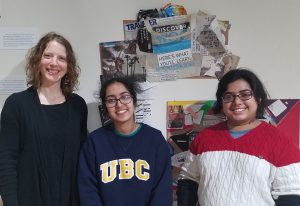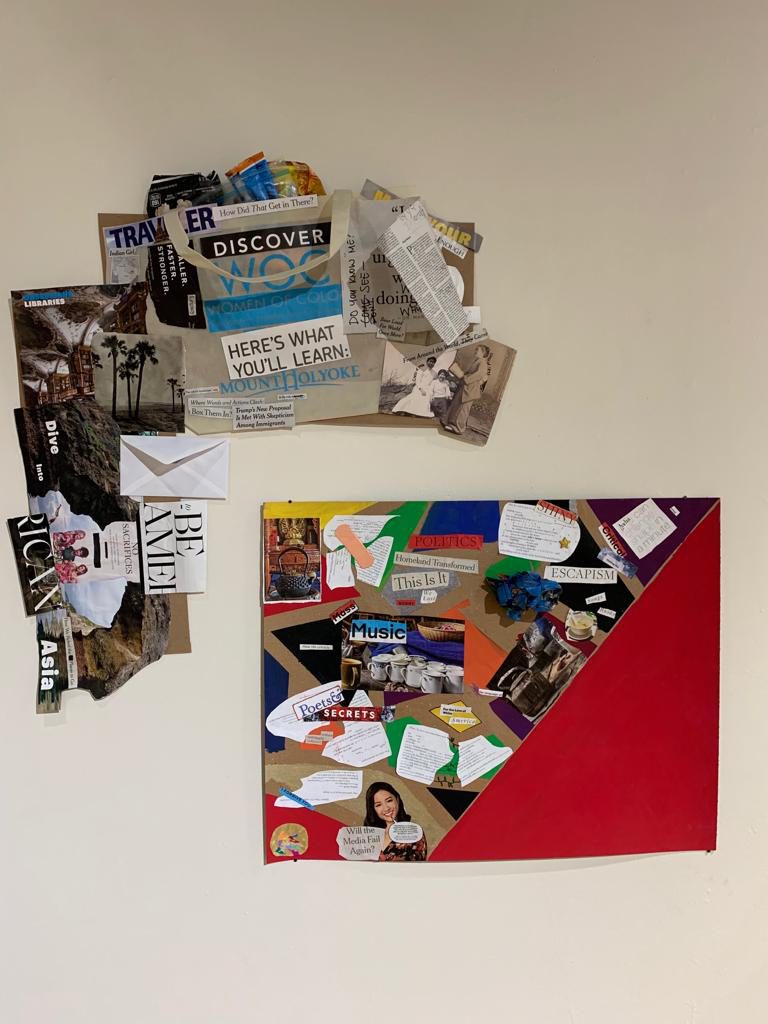 Pictured left to right: Professor Serin Houston, Anya Nandkeolyar ’19, and Shebati Sengupta ’19.
Pictured left to right: Professor Serin Houston, Anya Nandkeolyar ’19, and Shebati Sengupta ’19.
This installation grew out of a creative project assignment assigned in Professor Houston’s “Global Movements” course. Anya and Shebati worked together to create a mini art installation for that project. After that, they worked together to create the larger installation under the guidance of Professor Houston. Themes of migration and belonging are very salient to both of their lives, and they were excited to explore them through this medium.
The collages pictured below were created as part of the Building On Our Momentum (BOOM) workshop they ran. Anya’s is on the left, and Shebati’s is on the right.

Anya: I am a graduating senior at Mount Holyoke College and I use she/her/hers pronouns. I am a double major in Philosophy and Sociology and an international student.
Working on this project was an immense process of reflection. Considering this project and the ways I was engaging with its themes meant that I was also reconciling my identity in relation to those themes. As the project grew and my understanding of the themes was nuanced further, my relationship with my identity also shifted as I started to consider it on different terms.
The concepts of movement and migration had always been a part of what I saw as a core facet of my identity. I was born in a country only to move to several other countries after spending a few years in my nation of birth. The constant moving of my family across borders and spaces challenged my initial construction of my identity and I was forced to reexamine my identity over and over again as I entered new social spaces and spheres. This process of introspection became a familiar process for me, but I was not able to contextualize it until I took Global Movements and felt my anxieties about identity production and nationality echoed in the class discussions and reading materials.
The social world we exist in teaches us to process and acknowledge identities through certain frames, boundaries, and structures. These constructs impact the ways in which we engage with such identities (even and especially if they are our own identities). Many of these frames impacted the way I thought about my identity in the past and these frames will continue to affect the way I see myself and the rest of the world. Working on this art installation has been a good process of reflection because it has made me more aware of some of the more subconscious and internalized narratives. And so, when I was creating my collage, I was operating in a similar frame of mind where I was constantly reflecting on which articles, snippets, or images I was gravitating towards and which ones I was involuntarily ignoring or dismissing. The physical process of having through sift through the copious amount of newspapers available to us to create my collage was also a really reflective process because it mimicked my intellectual searching and interaction with the world. My identity shapes the way I look at the world and what I find to be salient to my perception and first focus. Looking through newspapers for specific wordings or headlines really helped bring that process to the forefront for me.
This project helped me see just how diverse and intersectional identity and knowledge production are. I hope that anyone who, had the chance to walk through the gallery space or have the chance to visit this digital archive of the space will be able to also reflect on their identity and question our traditional understandings of migration and home; and see how they exist differently for each individual.
Shebati: I am also a senior at Mount Holyoke (Class of 2019!). I use she/her/hers pronouns, and am currently majoring in Critical Social Thought with a minor in English.
I’m a domestic student, and was born and brought up in the US, but my parents did not grow up in this country. Being a part of the diasporic South Asian community, and going back to see my grandparents, cousins, aunts and uncles has informed my understanding of movement and belonging. Since coming to college, I have delved further into narratives of migration, inclusion, and exclusion. My focus within my major has been on borders, citizenship, and mechanisms of belonging. Global Movements helped bring my exploration and my studies outside of the United States, and reflect on my personal relationship with these topics in a deeper way.
This project helped me reflect on themes of perspective, movement, and home in a way which I usually do not. The medium of art (sculpture, collage, video) are not ones I usually utilize. Designing a project centered around these mediums was an exciting and new challenge. It allowed me to really think about visuals in aesthetics in relation to migration. It also allowed me to think about how certain representations are interpreted differently by different people. For example, depending on your experiences and sociocultural context, our video of water might evoke ideas of: violence; purity; life; disaster; destruction; grief; joy; home; other.
One of my favorite parts of this project, and one of the ones which I learned the most from, was observing how people interacted with our themes and our artwork. During the BOOM workshop, we had some intense conversations about what home, distance, and travel meant to various people in the room. We talked about how home is sometimes a complicated feeling, rather than a place. We also talked about how certain topics surrounding migration are more salient to us than others, depending on who we are. While the exhibit was up, people interacted with it in different ways. We received questions during our reception. While nobody signed in to our little sign-in book, we could see the puzzle being gradually solved by different hands.
In the future, I hope to keep thinking about these themes, and discussing them with people. It’s so essential to deconstruct what they mean to us, so that we can figure out what they mean to other people and why. At a time when migration is becoming an increasingly present and heavy subject, the call to understand your own relationship with it and how that came to be is ever so important. I hope this project helped some people think through their perspectives, and why they manifest the way that they do.
